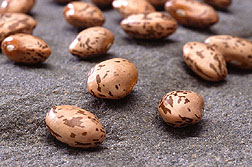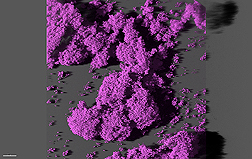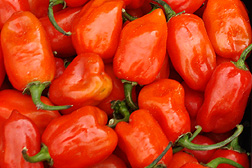| January 2010 |
Fungi May Hold Key to Reducing Grapefruit Juice Interactions with MedicationsA fungus may help solve the problem of a grapefruit compound that interacts negatively with certain prescription drugs, according to studies by ARS scientists. Grapefruit contains furanocomarins (FCs), which inhibit the enzymatic activity responsible for metabolizing certain prescribed medications and allowing more of the medication to enter the bloodstream. The study began with researchers testing a fungus—Aspergillus niger—to bind and break down FCs in grapefruit juice. Edible mushrooms such as morels, oyster and button mushrooms—when dried, pulverized and added to grapefruit juice—were also found to remove FCs. Scientific contact: Kyung Myung, (863) 293-4133, ext. 117, ARS Citrus and Subtropical Products Laboratory, Winter Haven, Fla. |
|
| Dehydration Affects Mood, Not Just Motor SkillsDehydration has long been known to compromise physical performance. Now, a new study provides insight into the effects of mild dehydration on young athletes, and possibly into the lives of people too busy to consume enough water daily. The researchers found that dehydration was associated with negative mood, including fatigue and confusion, compared to a hydrated group of participants. Scientific contact: Kristen E. D’Anci, (617) 627-4938, Department of Psychology, Tufts University, Boston, Mass. |
Culprit Compounds That Block Beans' Healthful Iron ProbedAn ARS animal physiologist and his Cornell University co-investigators are discovering more about natural compounds in foods that increase or, problematically, decrease absorption of iron from those foods as part of ongoing investigations. One current study with poultry builds on experiments from several years ago in Caco-2 human digestive system cells, cultured in petri dishes. In that study, it was determined that a natural compound known as kaempferol may be a key culprit in decreasing absorption of iron from red and pinto beans. Kaempferol is a polyphenol. Though scientists have known for decades that polyphenols interfere with absorption of iron from beans, the study was apparently the first to pinpoint a specific polyphenol in beans as a possible major player. Scientific contact: Raymond P. Glahn, (607) 255-2452, ARS Robert W. Holley Center for Agriculture and Health, Ithaca, N.Y. |
| ARS System to Detect Poultry Contamination Passes First Commercial TestTechnology developed by ARS scientists that automatically scans poultry carcasses for contamination has been successfully tested in a commercial poultry plant. The technology uses an improved hyperspectral imaging system that can detect small amounts of fecal contamination. Hyperspectral imaging is a technique that combines digital imaging with spectroscopy, creating individual wavelengths of light that pinpoint contaminants. The system is also being combined with another hyperspectral imaging camera that uses different wavelengths to differentiate systemically diseased poultry carcasses from wholesome ones. Merging the two systems will aid in commercialization by creating one interchangeable imaging system that can be installed in different locations of the processing line to solve two separate and significant processing problems. Scientific contact: Kurt Lawrence, (706) 546-3527, ARS Quality and Safety Assessment Research Unit, Athens, Ga. |
ARS, Company Team Up to Fight Biofilm Food ContaminationA new chemical formulation has been developed that could help meat processing plants keep work surfaces free of contamination. ARS tested a proprietary formulation for controlling biofilms that contain the foodborne pathogen Listeria monocytogenes. Biofilms are protective layers of proteins and polysaccharides that surround bacteria and stick to equipment surfaces. These protective shields trap spoilage bacteria and other pathogens that contaminate food during processing, and they resist cleaning and sanitizing. Longer production runs provide more opportunity for biofilms to establish themselves, and today's longer shelf life adds to the risk of contamination. Results showed that the formulation, made by Sterilex Corp. of Owings Mill, Md., was 100 percent effective, providing total kill and more than 90 percent biofilm removal. Scientific contact: Judy Arnold (retired), 706-546-3434, ARS Southeast Poultry Research Laboratory, Athens, Ga. |
|
| Research on Childhood Obesity May Help Fight EpidemicResearch funded by ARS may lead to new, cost-effective strategies to help America's kids make healthier food choices, manage their weight, and set and achieve fitness goals. In one early investigation, reported in 2008, the nutritional quality of kid-oriented "combo" meals offered at 10 well-known regional or national fast-food restaurant chains in Houston was scrutinized. Only 3 percent of the kids' meals met seven key standards set by the National School Lunch Program for meals intended for children in kindergarten through third grade, according to the researchers. Best-choice meals featured a deli-style sandwich combined with a fruit or a veggie that wasn't fried and low-fat milk as the beverage. Also making the grade: a kids' meal that featured a plain hamburger, fruit as a side and low-fat milk. Scientific contact: Jason A. Mendoza, (713) 798-7055, ARS Children's Nutrition Research Center, Houston, Texas. |
Latest Version of USDA's Premier Nutrient Database ReleasedARS’ flagship nutrient database has been updated with more than 200 new entries. The USDA National Nutrient Database for Standard Reference, Release 22, or SR22 for short, now includes a total of more than 7,500 food items. Among the 2009 updates, as many as 3,000 values for Vitamin D have been included for the first time. SR22 also includes a new food group, "Restaurant Foods." At this time, the restaurant foods group contains profiles for 38 food items obtained from family-style restaurants, Latino restaurants and Chinese restaurants. Scientific contact: Joanne Holden, (301) 504-0630, ARS Nutrient Data Laboratory, Beltsville, Md. |
|
| Roasting Does More than Enhance Flavor in PeanutsARS scientists have shown that increasing roast color intensity steadily ramps up the antioxidant capacities of peanuts, peanut flour and peanut skins. Dark-roasting consistently increased water- and oil-soluble antioxidant capacities for both commercially available peanut flours and blanched peanuts. Peanut skins, currently considered a waste product of industrial peanut processing, had remarkably high antioxidant capacities across all roast conditions. The researchers also measured vitamin E in the roasted peanuts. Vitamin E degradation was most rapid in oil from lightly roasted peanuts; however, oil from darker roasted peanuts had better vitamin E retention than that of lightly roasted or even raw peanuts. Scientific contact: Jack P. Davis, (919) 515-6312, ARS Market Quality and Handling Research Unit, Raleigh, N.C. |
New Pest-Resistant Habanero Joins Peck of ARS-Created PeppersA new red-fruited habanero, PA-559, is the latest pepper with resistance to root-knot nematodes to be released by ARS scientists. It has resistance to the southern root-knot nematode, the peanut root-knot nematode and the tropical root-knot nematode. The plant's fruit is extremely pungent, clocking in at 256,433 Scoville heat units. Habaneros typically score 100,000 or higher, whereas jalapeños range from 3,000 to 5,000 units. Scientific contact: Richard Fery, (843) 402-5300, ext. 530, ARS U.S. Vegetable Laboratory, Charleston, S.C. |
|










